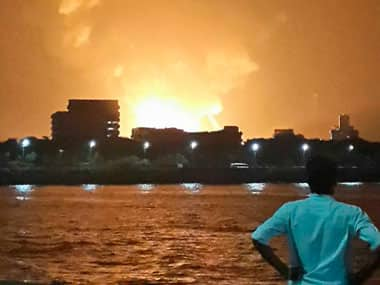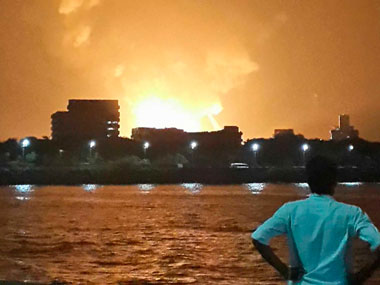INS Sindhurakshak was an all decked up war bride and ready for war drills simulating Pakistan as the enemy, when it sank after a series of explosions and a subsequent fire on 14 August in the Mumbai naval dockyard. But it ended up blowing up by itself! The big question is whether this was an act of sabotage, or even a terror plot? Were any terror outfits behind it? Or was it just a human error or a technical snag? These are the questions that dominate the minds of not just the Indian Navy today but the entire strategic establishment of India. [caption id=“attachment_1042585” align=“alignleft” width=“380”]  The fire visible from South Mumbai: Reuters[/caption] The Indian Navy’s top most priority after bringing the submarine ashore will be to find out with some finality whether the sinking of the Sindhurakshak was an accident triggered by human error or technical snag; or whether there was some foul play behind it. But this is going to take weeks. The 16- year-old submarine has cost the Indian Navy through its nose. After taking into account its midlife-upgrade in Russia, completed last year, during which it was equipped with new missiles, avionics and sonar systems, the boat had cost India upwards of $150 million. What went wrong on the night of 13-14 August which triggered the first explosion ten minutes after midnight that led to Sindhurakshak’s total gutting and sinking? Already some galling questions have surfaced, though the Indian Navy has so far not come up with any pointers suggesting sabotage. In fact, hush-hush voices emanating from the Indian Navy negate a sabotage theory. But then this point cannot be confirmed or ruled out till the submarine is brought to the shore and investigators examine the entire vessel. This stage is still several days away. That perhaps may be the reason why Defence Minister AK Antony has not made a statement in the parliament thus far. But Antony cannot wait for weeks to make a statement in parliament. His statement is expected by Tuesday but it is unlikely to touch upon the causes of the incident apart from saying that a Board of Inquiry is going on to determine what triggered the first explosion that led to a chain of explosions, a massive fire and the eventual sinking of the submarine. The terror question was first brought in by media reports in Russia, the country of origin for INS Sindhurakshak and from where it returned last year after a midlife-upgrade at the cost of $ 18 million. Russia’s Interfax news agency had carried a report soon after the sinking of INS Sindhurakshak citing an unnamed “military-diplomatic source” who claimed that the Indian submarine could have been the target of a terror plot. This source, according to Interfax, had opined that the submarine could not have suffered an accident while in its dock because most of its main systems would have been probably switched off. The Moscow Times published a report on 15 August quoting an Interfax news report saying that the explosion could have been caused by an act of sabotage, a hydrogen leak from the battery tank, a violation of technical rules or a system failure. “The Indian sailors could have been loading the ammunition and charging the vessel’s battery at the same time, which is strictly prohibited, a Russian shipbuilding specialist told Interfax. When loading the ammunition, the whole system is de-energized and hatches between the compartments are battened down — when charging the batteries the hatches must be open to provide ventilation, he said. The specialist also suggested that hydrogen afterburners in the boat’s nose compartment could not cope with the volume of gas emitted when charging the battery,” The Moscow Times report said. But then there are contrary reports interpreting similar circumstantial evidences differently and indicating a human/technical error. The parallel between the sinking of INS Sindhurakshak and the similar Russian Kilo class submarine Kursk, which sank with its entire crew of 118 during exercises in the Barents Sea on 12 August 2000, is striking. The Indian Navy will do well to take into account all events relating to the sinking of Kursk. Russia initially suspected that the Kursk was involved in a collision with a US submarine that was monitoring the Russian war games obviously aimed against the US. (INS Sindhurakshak too was preparing for simulated war games with Pakistan as the targeted enemy) However, when the Russian Navy concluded its investigation it was revealed that the most likely cause of the sinking of the Kursk was an explosion caused by a Type 65-76 torpedo within the submarine’s armaments chamber. INS Sindhurakshak too was equipped with similar Type 53 torpedoes. These torpedoes have a hallmark of being anti-submarine and anti-ship. INS Sindhurakshak was fitted with many such torpedoes at the time of the mishap, probably more than a dozen. The available footage of multiple explosions on INS Sindhurakshak on the fateful night will be of immense help for the investigators to pin down on the real cause of the first explosion that set off a chain reaction in the fully loaded submarine. However, even the report of the Board of Inquiry, which is already seized of the matter, is unlikely to be revealed to the public. The veil of mystery behind the causes of explosions aboard INS Sindhurakshak on 14 August needs to be lifted; the sooner, the better. More unanswered questions with regard to the sinking of INS Sindhurakshak are floating in the air. But then it is a developing story! Watch this space. *The writer is a Firstpost columnist and a strategic analyst. His Twitter handle is @Kishkindha
The big question is whether this was an act of sabotage, or even a terror plot? Were any terror outfits behind it? Or was it just a human error or a technical snag?
Advertisement
End of Article
Written by Rajeev Sharma
Consulting Editor, First Post. Strategic analyst. Political commentator. Twitter handle @Kishkindha. see more


)

)
)
)
)
)
)
)
)



